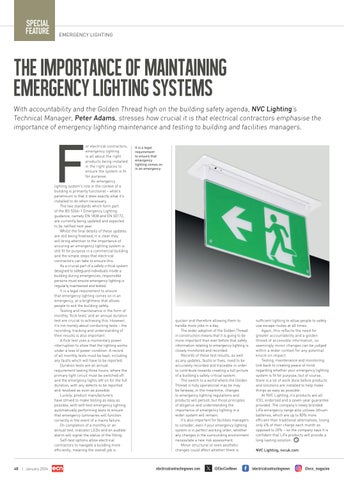SPECIAL FEATURE
EMERGENCY LIGHTING
THE IMPORTANCE OF MAINTAINING EMERGENCY LIGHTING SYSTEMS With accountability and the Golden Thread high on the building safety agenda, NVC Lighting’s Technical Manager, Peter Adams, stresses how crucial it is that electrical contractors emphasise the importance of emergency lighting maintenance and testing to building and facilities managers.
F
or electrical contractors, emergency lighting is all about the right products being installed in the right places to ensure the system is fit for purpose. An emergency lighting system’s role in the context of a building is primarily functional – what’s paramount is that it does exactly what it’s installed to do when necessary. The two standards which form part of the BS 5266-1 Emergency Lighting guidance, namely EN 1838 and EN 50172, are currently being updated and expected to be ratified next year. Whilst the final details of these updates are still being finalised, it is clear they will bring attention to the importance of ensuring an emergency lighting system is still fit for purpose in a commercial building and the simple steps that electrical contractors can take to ensure this. As a crucial part of a safety critical system designed to safeguard individuals inside a building during emergencies, responsible persons must ensure emergency lighting is regularly maintained and tested. It is a legal requirement to ensure that emergency lighting comes on in an emergency, at a brightness that allows people to exit the building safely. Testing and maintenance in the form of monthly ‘flick tests’ and an annual duration test are crucial to achieving this. However, it’s not merely about conducting tests – the recording, tracking and understanding of their results is also important. A flick test uses a momentary power interruption to show that the lighting works under a loss of power condition. A record of all monthly tests must be kept, including any faults which will have to be reported. Duration tests are an annual requirement lasting three hours, where the primary light circuit must be switched off and the emergency lights left on for the full duration, with any defects to be reported and resolved as soon as possible. Luckily, product manufacturers have strived to make testing as easy as possible, with self-test emergency lighting automatically performing tests to ensure that emergency luminaires will function correctly in the event of a mains failure. On completion of a monthly or an annual test, indicator LEDs and an audible alarm will signal the status of the fitting. Self-test options allow electrical contractors to navigate a building more efficiently, meaning the overall job is
48 | January 2024
Emergency Lighting (NVC Lighting).indd 48
It is a legal requirement to ensure that emergency lighting comes on in an emergency
quicker and therefore allowing them to handle more jobs in a day. The wider adoption of the Golden Thread in construction means that it is going to be more important than ever before that safety information relating to emergency lighting is closely monitored and recorded. Records of these test results, as well as any updates, faults or fixes, need to be accurately recorded and traceable in order to contribute towards creating a full picture of a building’s safety critical system. The switch to a world where the Golden Thread is fully operational may be may be faraway, in the meantime, changes to emergency lighting regulations and products will persist, but those principles of diligence and understanding the importance of emergency lighting in a wider system will remain. It’s also important for facilities managers to consider, even if your emergency lighting system is in perfect working order, whether any changes in the surrounding environment necessitate a new risk assessment. Minor structural or even aesthetic changes could affect whether there is
electricalcontractingnews.com
@ElecConNews
sufficient lighting to allow people to safely use escape routes at all times. Again, this reflects the need for greater accountability and a golden thread of accessible information, so seemingly minor changes can be judged within a wider context for any potential knock-on impact. Testing, maintenance and monitoring link back to creating peace of mind regarding whether your emergency lighting system is fit for purpose, but of course, there is a lot of work done before products and solutions are installed to help make things as easy as possible. At NVC Lighting, it’s products are all ICEL endorsed and a seven-year guarantee provided. The company’s newly branded LiFe emergency range also utilises lithium batteries, which are up to 80% more efficient than traditional alternatives, losing only 4% of their charge each month as opposed to 20% – so the company says it is confident that LiFe products will provide a long-lasting solution. NVC Lighting, nvcuk.com
/electricalcontractingnews
@ecn_magazine
14/12/2023 15:32
